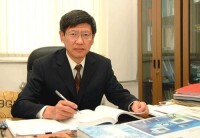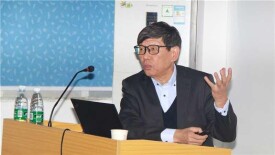彭永臻
彭永臻
彭永臻,男,中國工程院院士,工學博士,北京工業大學環境科學與工程學科首席教授、博士生導師,哈爾濱工業大學博士生導師,環境工程系主任兼水污染控制室主任。
2016年7月被中組部授予“全國優秀共產黨員”榮譽稱號。

彭永臻
中國城鎮供水排水協會常務理事,中國環境科學學會環境工程分會副主任委員,全國高等學校給水排水工程學科專業指導委員會委員,中國土木工程學會給水排水學會理事,中國工程建設標準化協會城市給水排水委員會委員,國際水學會(IWA)、日本水環境學會(JSWE)和美國水環境學會(WEF)會員。《環境科學學報》副主編,《北京工業大學學報》副主編,《中國給水排水》、《給水排水》和《Frontiers of Environmental Science & Engineering in China》等9本雜誌的編委。
先後獲黑龍江省優秀中青年專家、獲政府特殊津貼、“國家教學名師”、“全國模範教師”,“北京市人民教師提名獎”等稱號。
2015年中國工程院 土木、水利與建築工程學部院士增選的有效候選人,而且進入第二輪評選
2015年12月7日,當選中國工程院土木、水利與建築工程學部院士。
2016年7月1日,彭永臻院士在人民大會堂被授予“全國優秀共產黨員”稱號,是北京工業大學校首位獲此殊榮的黨員。
主要研究方向是污水生物處理的理論與應用、活性污泥法污水處理系統的自動控制與智能控制、水環境與污水處理工程的管理信息系統。
已完成5項國家自然科學基金和2項教育部優秀年輕教師基金等近30項國家與省部級科研項目,其中包括2004和2009年2次獲得國家科技進步獎二等獎,3次獲得省部級科技一等獎。領導的教學團隊於2007年被評為首批“國家級教學團隊”,負責的《水質工程學》和主講的《環境保護概論》先後獲國家精品課程。主編與參編了3本全國統編教材和5本專著,發表論文400餘篇,其中SCI檢索的論文130餘篇。獲得發明專利授權38項。指導的博士生中已有39人獲博士學位,並連續2次獲得“全國優秀博士學位論文”獎,另2次獲該項提名獎。
⒈“十一五”國家科技支撐計劃重點項目--SBR工藝城市污水處理廠節能降耗關鍵技術
⒉ “十一五”重大科技專項課題--景觀河湖水環境管理與水體補水保障研究;
⒊國家“十一五”重大科技專項課題--污水廠尾水作為城市河湖景觀補水的深度脫氮除磷技術;
⒋ 國家“863計劃”項目--活性污泥微膨脹節能理論與方法及中試研究。
⒌ 北京市教委科研基地--科技創新平台項目---污水脫氮除磷新理論與新工藝及節能降耗關鍵技術
⒍北京市自然科學基金重點項目(8091001)--城市垃圾滲濾液生物處理及短程生物脫氮新技術
⒎ 北京市高校人才強教深化計劃高層次人才資助項目--污水脫氮除磷新理論與新工藝及節能降耗關鍵技術
⒏ 國家自然科學基金---海外青年學者合作研究基金項目--聚磷菌和聚糖菌在強化生物除磷系統中競爭機理與控制;
⒐ 新加坡環境與水工業協會創新發展項目--低溶解氧污泥微膨脹節能理論與方法研究。
⒑ 新加坡環境與水工業發展協會項目--CSBR過程式控制制及強化脫氮除磷研究。
已主持了9項國家自然科學基金和2項教育部優秀年輕教師基金等30多項國家與省部級科研項目。先後獲得獲得了20餘項省部級優秀教學成果獎和科技進步獎,2004年、2009年和2012年共3次獲得國家科技進步獎二等獎。指導的博士生連續2次獲得“全國優秀博士學位論文”獎,另3次獲該項提名獎。
彭永臻(主編)、崔福義編著,《給水排水工程計算機程序設計》,中國建築工業出版社(1996);
彭永臻參編,《環境工程手冊》--水污染控制卷,高等教育出版社出版(1996);
崔福義,彭永臻,《給水排水工程儀錶與控制》,中國建築工業出版社(1999);
彭永臻主審,《水質工程實驗技術》,黑龍江教育出版社(2000);
彭永臻(主編)、崔福義編著,《給水排水工程計算機應用》,中國建築工業出版社(2002),;
李軍、楊秀山、彭永臻,《微生物與水處理工程》,化學工業出版社(2002);
王淑瑩、高春娣,《環境導論》,中國建築工業出版社(2004)(主審)
高景峰、彭永臻 譯,《污水處理系統的建模、診斷和控制》,化學工業出版社(2005);
祝貴兵、彭永臻 譯,《生物除磷的設計與運行手冊》,中國建築工業出版社(2005);
李圭白、張傑、彭永臻、崔福義等,《水質工程學》,中國建築工業出版社(2005);
彭永臻參編,《新英漢給水排水辭典》(許保玖等主編),中國建築工業出版社,2005年。
崔福義、彭永臻、南軍編著,《給水排水工程儀錶與控制》,中國建築工業出版社(2006);
馬勇,彭永臻著,《城市污水處理系統的運行與過程式控制制》,科學出版社,2007年。
馬勇,彭永臻譯著,《污水處理系統的儀錶、控制和自動化》,中國建築工業出版社,2007年
王曉蓮,彭永臻著,《A2O法污水生物脫氮除磷處理技術與應用》,科學出版社,2009年。
吳昌永,王然登,彭永臻著,《污水處理顆粒污泥技術原理與應用》,中國建築工業出版社,2011年
《SBR法污水生物脫氮除磷及過程式控制制》,科學出版社,2011年,彭永臻著
1.G. B. Zhu, S. Y. Wang, W. D. Wang, Y. Wang, L. L. Zhou, B. Jiang, H. J. M. Op den Camp, N. Risgaard-Petersen, L. Schwark, Y. Z. Peng, M. M. Hefting, M. S. M. Jetten,C. Q. Yin.Hotspots of anaerobic ammonium oxidation at land-freshwater interfaces.Nature Geoscience,2013,6(2):103-107.
2.D. W. Gao, Y. Z. Peng,W. M. Wu.Kinetic Model for Biological Nitrogen Removal Using Shortcut Nitrification-Denitrification Process in Sequencing Batch Reactor.Environmental Science & Technology,2010,44(13):5015-5021.
3.S. Y. Wang, G. B. Zhu, Y. Z. Peng, M. S. M. Jetten,C. Q. Yin.Anammox Bacterial Abundance, Activity, and Contribution in Riparian Sediments of the Pearl River Estuary.Environmental Science & Technology,2012,46(16):8834-8842.
4.Q. Yang, X. H. Liu, C. Y. Peng, S. Y. Wang, H. W. Sun,Y. Z. Peng.N2O Production during Nitrogen Removal via Nitrite from Domestic Wastewater: Main Sources and Control Method.Environmental Science & Technology,2009,43(24):9400-9406.
5.Q. Yang, Y. Z. Peng, X. H. Liu, W. Zeng, T. Mino,H. Satoh.Nitrogen removal via nitrite from municipal wastewater at low temperatures using real-time control to optimize nitrifying communities.Environmental Science & Technology,2007,41(23):8159-8164.
6.X. Li, Y. Peng, N. Ren, B. Li, T. Chai,L. Zhang.Effect of temperature on short chain fatty acids (SCFAs) accumulation and microbiological transformation in sludge alkaline fermentation with Ca(OH)(2) adjustment. Water Research,2014,61(34-45.
7.S. J. Ge, Y. Z. Peng, S. Qiu, A. Zhu,N. Q. Ren.Complete nitrogen removal from municipal wastewater via partial nitrification by appropriately alternating anoxic/aerobic conditions in a continuous plug-flow step feed process.Water Research,2014,55(95-105.
8.J. H. Guo, Y. Z. Peng, Z. W. Wang, Z. G. Yuan, X. Yang,S. Y. Wang.Control filamentous bulking caused by chlorine-resistant Type 021N bacteria through adding a biocide CTAB.Water Research,2012,46(19):6531-6542.
9.Y. Ma, Y. Z. Peng, S. Y. Wang, Z. G. Yuan,X. L. Wang.Achieving nitrogen removal via nitrite in a pilot-scale continuous pre-denitrification plant.Water Research,2009,43(3):563-572.
10.Y. Z. Peng, S. J. Zhang, W. Zeng, S. W. Zheng, T. Mino,H. Satoh.Organic removal by denitritation and methanogenesis and nitrogen removal by nitritation from landfill leachate.Water Research,2008,42(4-5):883-892.
11.C. Y. Wu, Y. Z. Peng, S. Y. Wang,Y. Ma.Enhanced biological phosphorus removal by granular sludge: From macro- to micro-scale.Water Research,2010,44(3):807-814.
12.Y. Z. Chen, C. Y. Peng, J. H. Wang, L. Ye, L. C. Zhang,Y. Z. Peng.Effect of nitrate recycling ratio on simultaneous biological nutrient removal in a novel anaerobic/anoxic/oxic (A(2)/O)-biological aerated filter (BAF) system.Bioresource Technology,2011,102(10):5722-5727.
13.D. W. Gao, Y. Z. Peng, B. Li,H. Liang.Shortcut nitrification-denitrification by real-time control strategies.Bioresource Technology,2009,100(7):2298-2300.
14.S. J. Ge, Y. Z. Peng, S. Y. Wang, J. H. Guo, B. Ma, L. A. Zhang,X. Cao.Enhanced nutrient removal in a modified step feed process treating municipal wastewater with different inflow distribution ratios and nutrient ratios.Bioresource Technology,2010,101(23):9012-9019.
15.J. H. Guo, Y. Z. Peng, C. Y. Peng, S. Y. Wang, Y. Chen, H. J. Huang,Z. R. Sun.Energy saving achieved by limited filamentous bulking sludge under low dissolved oxygen.Bioresource Technology,2010,101(4):1120-1126.
16.J. H. Guo, Y. Z. Peng, S. Y. Wang, Y. A. Zheng, H. J. Huang,Z. W. Wang.Long-term effect of dissolved oxygen on partial nitrification performance and microbial community structure.Bioresource Technology,2009,100(11):2796-2802.
17.W. G. Jie, Y. Z. Peng, N. Q. Ren,B. K. Li.Utilization of alkali-tolerant stains in fermentation of excess sludge.Bioresource Technology,2014,157(52-59.
18.Y. Z. Peng,S. J. Ge.Enhanced nutrient removal in three types of step feeding process from municipal wastewater.Bioresource Technology,2011,102(11):6405-6413.
19.Y. Z. Peng, L. Zhang, S. J. Zhang, Y. P. Gan,C. C. Wu.Enhanced nitrogen removal from sludge dewatering liquor by simultaneous primary sludge fermentation and nitrate reduction in batch and continuous reactors.Bioresource Technology,2012,104(144-149.
20.Y. Y. Wang, Y. Z. Peng,T. Stephenson.Effect of influent nutrient ratios and hydraulic retention time (HRT) on simultaneous phosphorus and nitrogen removal in a two-sludge sequencing batch reactor process.Bioresource Technology,2009,100(14):3506-3512.
21.X. Yang, Y. Z. Peng, N. Q. Ren, J. H. Guo, X. X. Tang,J. C. Song.Nutrient removal performance and microbial community structure in an EBPR system under the limited filamentous bulking state.Bioresource Technology,2013,144(86-93.
22.J. H. Guo, Y. Z. Peng, S. Y. Wang, B. Ma, S. J. Ge, Z. W. Wang, H. J. Huang, J. R. Zhang,L. Zhang.Pathways and Organisms Involved in Ammonia Oxidation and Nitrous Oxide Emission.Critical Reviews in Environmental Science and Technology,2013,43(21):2213-2296.
23.J. F. Gao, Q. Zhang, K. Su, R. N. Chen,Y. Z. Peng.Biosorption of Acid Yellow 17 from aqueous solution by non-living aerobic granular sludge.Journal of Hazardous Materials,2010,174(1-3):215-225.
24.Y. K. Gong, Y. Z. Peng, Q. Yang, W. M. Wu,S. Y. Wang.Formation of nitrous oxide in a gradient of oxygenation and nitrogen loading rate during denitrification of nitrite and nitrate.Journal of Hazardous Materials,2012,227(453-460.
25.J. H. Guo, Y. Z. Peng, H. J. Huang, S. Y. Wang, S. J. Ge, J. R. Zhang,Z. W. Wang.Short- and long-term effects of temperature on partial nitrification in a sequencing batch reactor treating domestic wastewater.Journal of Hazardous Materials,2010,179(1-3):471-479.
26.J. Ma, Q. Yang, S. Y. Wang, L. Wang, A. Takigawa,Y. Z. Peng.Effect of free nitrous acid as inhibitors on nitrate reduction by a biological nutrient removal sludge.Journal of Hazardous Materials,2010,175(1-3):518-523.
27.Y. Z. Peng, J. H. Guo, H. Horn, X. Yang,S. Y. Wang.Achieving nitrite accumulation in a continuous system treating low-strength domestic wastewater: switchover from batch start-up to continuous operation with process control.Applied Microbiology and Biotechnology,2012,94(2):517-526.
28.Y. Z. Peng,G. B. Zhu.Biological nitrogen removal with nitrification and denitrification via nitrite pathway.Applied Microbiology and Biotechnology,2006,73(1):15-26.
29.J. H. Guo, Y. Z. Peng, X. Yang, C. D. Gao,S. Y. Wang.Combination process of limited filamentous bulking and nitrogen removal via nitrite for enhancing nitrogen removal and reducing aeration requirements.Chemosphere,2013,91(1):68-75.
30.C. Y. Wu, Y. Z. Peng, R. D. Wang,Y. X. Zhou.Understanding the granulation process of activated sludge in a biological phosphorus removal sequencing batch reactor.Chemosphere,2012,86(8):767-773.
31.L. Zhang, S. J. Zhang, Y. P. Gan,Y. Z. Peng.Bio-augmentation to rapid realize partial nitrification of real sewage.Chemosphere,2012,88(9):1097-1102.
32.L. Zhang, S. J. Zhang, S. Y. Wang, C. C. Wu, Y. G. Chen, Y. Y. Wang,Y. Z. Peng.Enhanced biological nutrient removal in a simultaneous fermentation, denitrification and phosphate removal reactor using primary sludge as internal carbon source.Chemosphere,2013,91(5):635-640.
33.W. T. Zhang, Y. Z. Peng, N. Q. Ren, Q. S. Liu,Y. Z. Chen.Improvement of nutrient removal by optimizing the volume ratio of anoxic to aerobic zone in AAO-BAF system.Chemosphere,2013,93(11):2859-2863.
34.Y. Ma, Y. Z. Peng,X. L. Wang.Improving nutrient removal of the AAO process by an influent bypass flow by denitrifying phosphorus removal.Desalination,2009,246(534-544.
35.Y. Z. Peng, X. L. Wang,B. K. Li.Anoxic biological phosphorus uptake and the effect of excessive aeration on biological phosphorus removal in the A(2)O process.Desalination,2006,189(1-3):155-164.
他年近七旬,一直堅守在教學和科研的第一線。堅持用獨創的“過程式控制製法”培養學生,培養工學博士62人,有2人獲全國百篇優秀博士學位論文獎、4篇獲提名獎,12人已成為教授、博導、教授級高工或研究員。堅持為本科生上課,將深奧的科學原理變得不再晦澀難懂,常有其他學生慕名旁聽,講授的《水質工程學》和《環境保護概論》被評為國家級精品課程。始終把國家的需要作為自己的研究與攻關方向,圍繞解決北京水資源短缺及城市污水處理問題潛心鑽研,研發的污水處理節能降耗新技術與工藝成功解決了酒仙橋、方庄污水處理廠污泥膨脹和上浮問題,創新提出“活性污泥微膨脹節能理論與方法”,達到國際領先水平。2015年當選為中國工程院院士后,婉拒配車配秘書的待遇,只是提出爭取在學校建立國家重點實驗室,進一步推動學科發展。他不僅教授學生知識,還扶助年輕學子在做人做事上健康成長,堅持與學生一起“泡”在實驗室做科研,要求學生髮表論文前要反覆試驗,培養嚴謹的科學態度。
